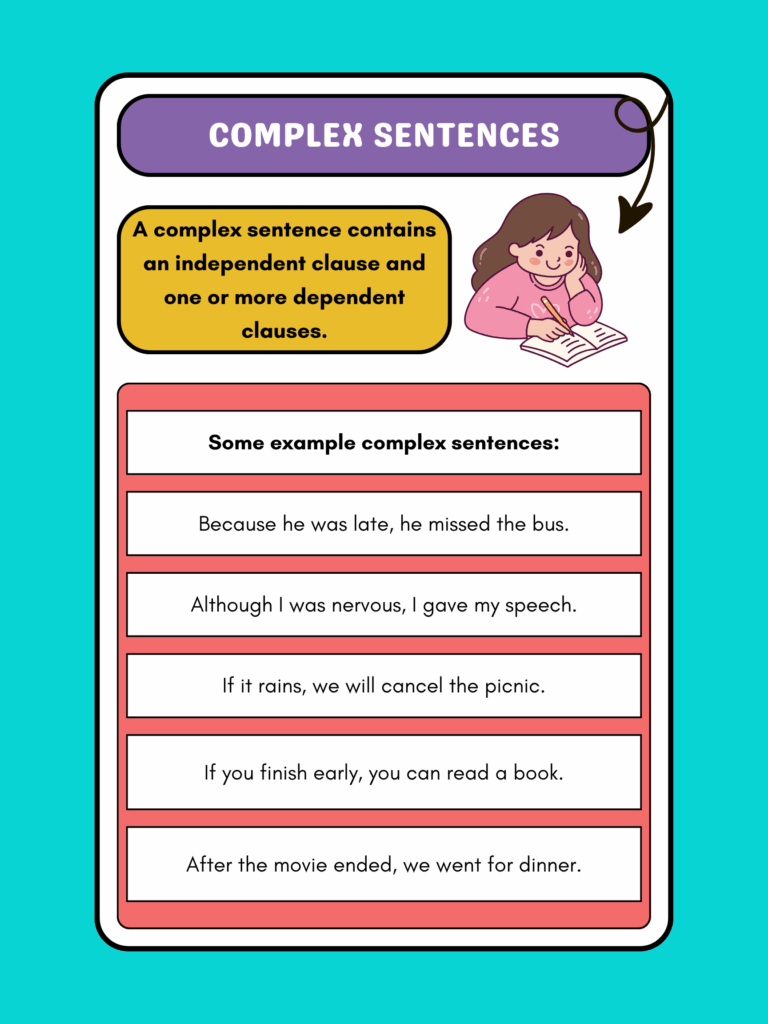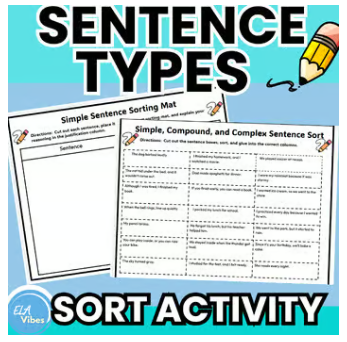If your students are mixing up sentence types or struggling with run-ons, you’re not alone. Teaching sentence structure can feel overwhelming, especially with vocabulary like independent clause, subordinate clause, and FANBOYS in the mix. But once students understand how sentences work, their writing improves fast. This post breaks down how to teach simple, compound, and complex sentences in a clear, practical way. You’ll get examples, visuals, anchor chart ideas, and hands-on activities that help students build strong sentence skills. I’ll also answer common questions like “How do I know if it’s compound or complex?” and “When do I use a comma with conjunctions?”

How Do You Explain Compound and Complex Sentences?
There are different types of sentences, but the first things students need to master are the basics of a single sentence. Every complete sentence has at least one subject and one verb. That gives us a complete thought. From there, we can expand to compound and complex structures.
A compound sentence is two separate sentences (independent clauses) joined with a coordinating conjunction like “and,” “but,” or “so.” Each part is an independent clause, meaning it can stand alone.
A complex sentence has one independent clause and one or more subordinate (dependent) clauses. These clauses can’t stand alone and often start with subordinating conjunctions like “because,” “although,” or “when.”
Here’s the difference:
Compound: I wanted to go outside, but it started to rain.
Complex: I stayed inside because it started to rain.
Compound sentences show equal ideas. Complex sentences show one main idea and one that depends on it.


How to Teach Simple, Compound, and Complex Sentences
Start small. Here’s a gradual teaching progression that works well in upper elementary:
Simple Sentences:
- Use mentor sentences from familiar texts.
- Identify subjects and verbs together.
- Sort phrases into complete vs incomplete thoughts.
- Build and expand short sentences.
Compound Sentences:
Highlight compound sentence examples so students can spot the pattern.
- Teach FANBOYS (For, And, Nor, But, Or, Yet, So) with anchor charts.
- Practice joining short sentences using coordinating conjunctions.
- Use color coding to identify independent clauses.
- Create compound sentence puzzles by combining cut-up clauses.
- Highlight compound sentence examples so students can spot the pattern.

What punctuation is used with FANBOYS?
Use a comma before the FANBOYS word when combining two independent clauses. Example: I was tired, but I kept reading.
What’s a trick to remember FANBOYS?
Use the acronym itself. Use memory tricks and visuals.
- Make a FANBOYS anchor chart with examples for each conjunction.
- Practice one per day with sentence starters.
- Use sentence puzzles: give two short sentences and ask students to choose the best FANBOYS to join them.
- Use a FANBOYS spinner: students spin and create a sentence using the word they land on
Example: I like pizza. I don’t like olives.
Joined: I like pizza, but I don’t like olives.
Complex Sentences:
- Introduce subordinating conjunctions (because, although, if, when, since).
- Sort clauses into independent and dependent.
- Model with mentor sentences and sentence starters.
- Show how word order can change but meaning stays:
- Because it was raining, we stayed in.
- We stayed in because it was raining.

What Is the Easiest Way to Identify a Complex Sentence?
Look for a subordinating conjunction or a relative pronoun (that, which, who). Then ask:
- Does part of this sentence depend on the other part to make sense?
- Can one part stand alone as a complete sentence, and the other cannot?
If the answer is yes, it’s likely a complex sentence.
Examples: Although I was tired, I finished my homework.
- “Although I was tired” = dependent clause (can’t stand alone)
- “I finished my homework” = independent clause
Teach students to underline the main clause and circle the subordinate clause. Use graphic organizers to break apart clauses and label them. Sentence structure activities that sort sentences by type are also helpful.
How do you know if a sentence is compound or complex?
Here’s a quick check:
- Are there two independent clauses joined by a coordinating conjunction (FANBOYS)? That’s compound.
- Is there one independent clause and one or more dependent clauses (starting with a subordinating conjunction)? That’s complex.
Use a sentence types worksheet to give students extra practice. Identifying the type of sentence is a great way to catch common mistakes like fragments and run-ons.
Download this sorting activity to master simple, complex, and compound sentences. Click here.

How Can I Visually Show Independent vs Subordinate Clauses?
Try:
- Color coding: One color for independent, one for subordinate.
- Sentence flip books: Put one clause on each flap and label them.
- Clause cut-and-paste: Students match and build complete sentences using labeled strips.
Keep visuals accessible in a writing notebook or sentence structure folder.
How many clauses are in a complex sentence?
One independent clause and at least one dependent clause. That’s what separates it from a simple or compound sentence.
Mentor Sentences for Complex Structures
Pull strong examples from class texts or read-alouds. Use mentor sentences that:
- Begin with subordinating conjunctions
- Include relative clauses
- Show variety in structure
Have students:
- Label the clauses
- Mimic the structure with their own topic
- Revise a short paragraph to add a complex sentence
TYPES Of Sentences Examples
Create an anchor chart with examples:
| Sentence Type | Example |
|---|---|
| Simple | I read every night. |
| Compound | I like to read, and I enjoy writing too. |
| Complex | When I read, I feel calm. |
| Compound-Complex | I wanted to read, but since I was tired, I fell asleep. |
What Are 5 Examples of Compound-Complex Sentences?
- Although the movie was long, we stayed until the end, and we even watched the credits.
- I brought my umbrella because it looked like rain, but it stayed sunny all afternoon.
- We can start our project now, or we can wait until Diego finishes his draft, which he started yesterday.
- When I saw the lightning, I ran inside, and my brother followed.
- She wanted to join the club, but since she missed the meeting, she has to wait until next week.
Each example includes at least two independent clauses and one dependent clause. Highlight the subordinate conjunctions and coordinating conjunctions to make the structure clear.
Conclusion: Compound and complex Sentences
Helping students master sentence types builds stronger writing, clearer communication, and more sentence variety. By teaching the differences between simple, compound, complex, and compound-complex sentences using visuals, mentor texts, and practice activities, students begin to use more advanced sentence structures in their own writing. Start small, go slow, and revisit often. Sentence structure is one of those skills that builds over time. A strong foundation now means fewer comma splices, more complete thoughts, and better writing down the road.
Additional Resources to Add to Your Toolbox

Favorite Amazon Items to Support Different Types of Sentences
This post contains affiliate links, which means I may earn a small commission at no extra cost to you. I only share resources I truly love and use myself—thanks for supporting my corner of the teacher world!

